What ’s it really like to play Augusta National? Golf Australia Editor Brendan James played it after last year's Masters and found it was like a hundred dreams coming true.
BY BRENDAN JAMES
During the past 30-odd years I reckon I have played Augusta National hundreds, perhaps thousands, of times. Never a full round mind you. I have played five or six holes here and there, or at least that’s about as many as I can remember when I wake in the morning after another ‘Augusta Dream’.
Some people count sheep, others go down the pharmaceutical route to drift off to sleep. For me, I close my eyes as the head hits the pillow and let my imagination drift towards Georgia. Of course, in the dream world there are no bad shots, only good ones, there are no nerves and you might just find yourself teeing up alongside Greg Norman (a regular playing partner for years), Jack Nicklaus or even a couple of mates out for a hit.
It is often said that the bridge between dreams and reality is hard work. But for one day in April this year, more than three decades of recurring dreams became reality, not through hard work, but good ol’ dumb luck.
There are a handful of ways to strike the golfing jackpot and get the opportunity to play Augusta National. You can become a member of the famed club, but you might have more chance winning Lotto. You can be invited by a member, which gives you a slightly better chance … probably a million to one. You can start practicing now, crack a spot in the top-50 of the world ranking or win on the PGA Tour and qualify to play the Masters. Then there is the route I took.
Every member of the media covering the Masters Tournament enters a lottery for one of the treasured tee times to play Augusta National the day after the final round. There are 24 spots available. When you exclude anyone who has won a tee time in the past seven years, you feel buoyant that you have about a one in 15 chance. But you are quickly brought back to earth by stories that circulate of journalists and photographers, who have been covering the Masters for 20 years that have never had their name pulled out in the ballot.
At 10.15am on April 12, about 90 minutes into the third round of the Masters, the list of the media lottery winners was posted at the Media Centre reception and there, just three lines from the top was my name. Two names below was Mark Hayes, a good mate and chief golf writer of Melbourne’s Herald Sun newspaper. I walked briskly to the men’s room, found an empty cubicle and danced a little jig in private, to do so in public might have been considered uncool.
I went back to my desk but work was out of the question, at least for now. My mind was racing … I’m going to play Augusta.
***
Fifteen hours after Bubba Watson slipped into his second Green Jacket, I was taking my own memorable drive down Magnolia Lane – my journey in the footsteps of the golfing Gods had begun.
We’ve all heard how special the drive up Magnolia Lane is and I have to admit it did give me goosebumps to think every great golfer from Bobby Jones to Adam Scott has driven the 300 metres from the front gate off Washington Road to the clubhouse. I’ve no doubt, like me, they were in awe at the beauty of 150-year-old magnolias (there is now 60 of them after one was lost in a severe storm in 2011) that line the route.
A club concierge was there to greet me as I pulled up in front of the clubhouse. My clubs were whisked away to the practice area, and the car was valet parked while I was led inside and pointed in the direction of the Champions locker room. I climbed the narrow spiral staircase to the first floor and walked bug-eyed into the locker room.
The locker room attendant, Richard, greets me with a huge smile and was as welcoming as if I was one of the Masters champions he’d assisted all week. He’s been working here for 30 years and has seen all the champions walk through his door. Yet he’s never seen one shot played live at the Masters, he’s always working.
“You’re from Australia?” he enquires. “Oh…your Mr Scott is a fine player.
“This is his Green Jacket,” he adds as he leads me over to the glass display case at the side of the room where Scotty’s jacket is on show. Watson’s jacket will replace it before the 2015 tournament. Above, a replay of the Masters final round is on The Golf Channel, and underneath is a bar fridge with a range of drinks.
Richard then assigns me my locker for the day, the same one used by Sam Snead and Ralph Guldahl and I settle down in one of the green leather chairs to change my shoes. With laces tied I look up and realise I’m facing Arnold Palmer’s locker. The Champions Locker Room is so small – about six metres long by three metres wide – all the lockers are shared except for one. For example, Scott shares with Gary Player and Zach Johnson bunks in with Billy Casper. But Arnie has a locker for himself.
Augusta National loves it’s past champions. Always has. The likes of Nicklaus and Player are revered. But there is genuine love here for Palmer, the man they call the ‘The King’. He can still pull a crowd, even just walking from the clubhouse to the car park.
The King played his last competitive round at Augusta in 2004, aged 74. He shot 84-84 to miss the cut in what was his 50th Masters appearance. Spotting Arnie’s name plaque on his locker gave me an idea – a 10-marker, nearly 30 years younger, playing off the member’s tees might just be half a chance to beat The King’s closing mark.
Ten minutes on the practice range and I had my doubts.
A day earlier I watched Bubba Watson play a myriad of pure golf shots from the same spot on the range I now occupied. Three or four sculled wedges, a shanked 6-iron and a snap hooked 4-iron lowered the standard immediately and The King’s 84 was not in any danger at all.
A fat 3-wood followed and I looked back at my caddie, Butch, and immediately felt sorry for him. The mercury was already climbing through the high 20s and he was going to have to haul my bag across the undulating Augusta National landscape for more than four hours with little prospect of a single highlight.
Butch, a retired college lecturer on media and marketing, is a freelance caddie, who lives in Aiken just across the border into South Carolina. He caddies at Augusta when loopers are needed and at other times he’s at Augusta Country Club or the exclusive Sage Valley, south of Augusta. He reminds me of a taller version of former Prime Minister John Howard. Think Howard’s glasses and bushfire prone eyebrows, but with a southern American accent, and you’ve got Butch.
Despite my calamitous efforts on the range, there were few nerves walking to the 1st tee. I guess you really only have a reason to get nervous if you have expectations and mine had just been shattered in a 20-minute practice session. But you couldn’t wipe the small off my face as Butch handed me my driver and said, “enjoy.”
I could shoot a 100 and leave the course happy. But when you know the first question someone will ask you when they learn you have played Augusta is “what did you shoot?”, you’d rather reply with a number starting with seven or eight than ‘100’.
The course for our round was prepared just as it was for each day of the Masters, with the only thing missing being the 20-odd kilometres of gallery ropes, which had been taken down overnight. The greens were cut and rolled and the Sunday pin positions kept. We played from the member’s tees, which were between 10 yards (on the 12th) and 105 yards (on the 11th) in front of the final round tournament tees.
The starter handed me my scorecard and it immediately struck me that the yardages for each hole are given in multiples of five. Apparently, the club’s founder and first chairman Clifford Roberts thought it was ridiculous to have a more precise number when the flags and tees were moved to different locations on a daily basis.
With no expectations, I stood over the ball for my opening drive and took aim at the wide expanse of fairway to the left of the huge bunker hugging the right edge of the fairway. The swing was smooth and contact was solid … solid enough, but my ball was blocked right and flew straight into the aforementioned bunker.
I was the only player in our group to miss the 1st fairway and I hoped this wasn’t going to set the tone for the remainder of the round. Let’s just say I was relieved to get my 7-iron out of the sand and up the fairway, somewhere near the green, and thankful for my two-putt bogey.
Another two-putt bogey at the long par-4 5th hole, mixed with pars at the 2nd, 3rd, 4th and 6th holes had my scorecard looking in pretty good shape standing on the 7th tee. There was even a bounce in Butch’s step, which had been lacking before the round.
A drive down the middle of the 7th fairway, followed by a 9-iron to two feet from the cup leads to an easy birdie, and Butch marched to the 8th tee with all the determination of Steve Williams in hot pursuit of a major.
A tap-in par on the long par-5 and I was unbelievably, given the pre-round antics, one-over-par standing on the 9th tee. Golf is a funny game.
Having hit my drive ideally down the right edge of the 9th fairway, I was left with 170 yards uphill to the flag. For the first time in the round I entertained the thought of making an aggressive play by hitting a draw into the right half of the green so it would ideally feed around towards the flag. Until now I had been happy with pars but now I wanted a birdie.
All the great players with years of Masters experience talk about having to be patient to make a good score at Augusta. “You’ve got to know when to attack and when to be conservative and play for the middle of the green,” they say. I should have listened more closely. My intended draw turned into a hook and left me short-sided in the bottom of the front bunker. I got the ball out but and was left with a slick downhill putt from 25 feet with about 20-foot of break. Four putts later and a big fat ‘7’ was annoyingly added to the scorecard.
Alister MacKenzie, who originally designed Augusta National, thought the current 10th hole was the ideal starting hole for the layout. The view from the tee can be mesmerising as the fairway drops more than 30 metres as it doglegs left through a corridor of pine trees. The steep slope rewards any player who can hit the ball from right-to-left, while the slight mis-hit or fade to the right is accommodated. Having hit my best drive of the day – a big raking hook that seems to run for miles – I walk confidently off the tee and descend into the most celebrated back nine in the game.
From the middle of the 10th fairway, I was able to find another double bogey. With the ball sitting above my feet there was little I could do to avoid hooking another iron left of the target and into the scrub you never really see on television.
Augusta was getting the upper hand once more. However, a regulation par on the 11th steadied the ship, or at least I thought it did.
The 12th hole lies at the heart of Amen Corner. It appears to be a straightforward par-3 of 156 yards (142 metres). As you stand on the tee here with a short iron in hand, it’s not the shot that scares you most it’s the images of the game’s best players coming unstuck here. I was standing behind the tee here during the third round when Gary Woodland, who was seven under through 10 holes, put his tee shot into Rae’s Creek and made a double bogey five. Two days earlier, Scott did similar. At least they both got their tee shot on the clubface. I hit perhaps the worst tee shot ever on the 12th hole – a massive shank that didn’t even make the water. The ball skews so far right it’s directly in front of the 13th tee. Butch says: “I can’t give you a yardage as I’ve never been in this position before.”
I decide to wing it and promptly put my second shot in the water and rack up a six. A boring par would have been far less memorable and I can safely say it was the most enjoyable triple bogey I’ve ever made.
A two-putt par on the 13th and a bogey at the 14th had me at 10 over par and my goal of beating The King’s 84 looked increasingly unlikely.
The back nine at Augusta has provided some of the great finishes in major championship history. The par-5 15th hole has always played a pivotal role in deciding who will wear the Green Jacket, simply because players feel they can help their cause with an eagle or birdie. I had a similar thought.
My drive into a slight breeze left me with 217 yards to carry the pond in front of the green below (it was surprising how much steeper the drop to the green looks from the middle of the fairway). I hit a 3-wood as well as I could hit and watch as it climbed to its apex and dropped like a stone … near the back edge of the green. There were high fives all around and they continued when Hayesy, pumped after making birdie on the 14th hole, flushed a 4-iron onto the green and his ball came to rest about 18 feet from the cup. I was happy with a three-putt par, given I had to roll my putt across a narrow shelf, while Mr Hayes narrowly missed his eagle and tapped in for birdie.
The par-3 16th, with the members tees up, was playing the same length as the 12th, where I had used a 7-iron so poorly about 45 minutes earlier. Now I had the offending club in my hands again and the word ‘shank’ was bouncing around inside my head. Earlier in the round, Butch had advised that aiming at the TV towers behind the greens was a good game plan and on the 16th it was no different. That line would see the ball hit the green and roll down the slope to that final round pin position we have all become familiar with. Sounded easy enough! The ball hit the middle of the clubface this time around and was flying straight down the line of the tower, it hit the green, about 2 feet long of being perfect, bounded through the back into the thick primary cut. Could have been worse, could have had a shank!
A chip and two-putt and I settled for a bogey four. Another bogey on the 17th, courtesy of a three-putt from above and beyond the hole, had me sitting at 12-over-par and tied with The King’s score with one hole to play. For the first time in the round I had to concentrate on not gripping the club like I was hanging from a rope. Conversely, Hayesy was two-under for the last four holes after making a botched effort on the 13th hole. There was more adrenalin than red blood cells pumping through his veins.
With my tee shot on the left side of the fairway – level with the halfway gap between the two bunkers left – I walked slowly up the hill, partly from being absolutely knackered (Augusta National is a tough walk) and not really wanting the round to end. I stood behind the ball and Butch gave me the numbers: “you’ve got 147 yards to the flag … anything to 151 yards will roll back down to the hole,” he said.
That infamous 7-iron was entrusted again. Good strike, good line (at the TV tower) but the ball drifted just right of the flag. It touched down just long of pin high, trickled back down the slope to leave a slightly shorter version of the putt Adam Scott made on the 72nd hole on his way to winning the Masters in 2013. Unlike our first Masters winner, I dogged the putt and left it short, by about two rolls, going into the heart of the cup. I tapped in for par and the round was done (interestingly in just three hours and 50 minutes). The imaginary match between The King and I had finished square … I had shot 84 and was ecstatic.
But it was time to leave. Needless to say Hayesy, who had just made a great bogey from the 10th fairway, and I lingered like a pair of blokes up to no good. I’m sure we broke the record for the slowest walk ever to cover the 100 metres from the 18th green to the clubhouse, as we absorbed our last views of the famous course as players, not spectators, and brought to an end a day only dreams are made of.
Related Articles
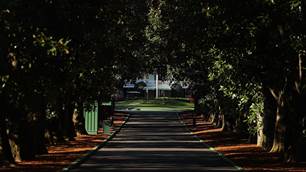
Australian Open winner will receive invite to The Masters

Drinks With... Ricky Ponting


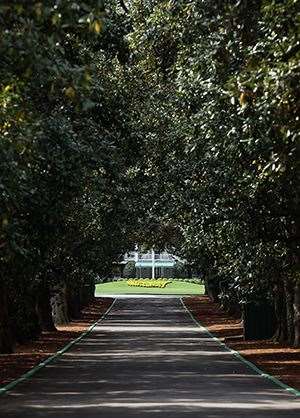
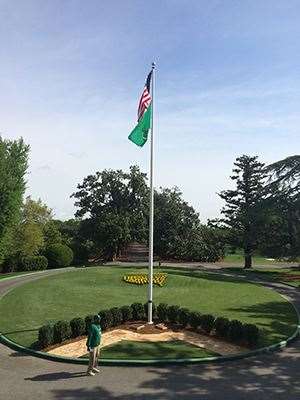
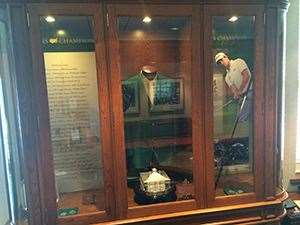
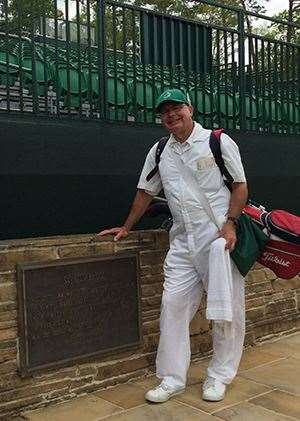
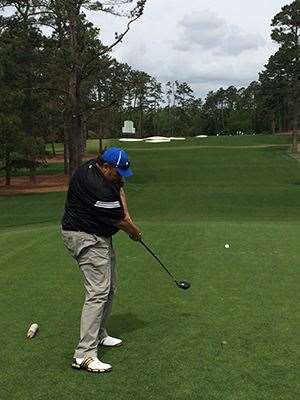
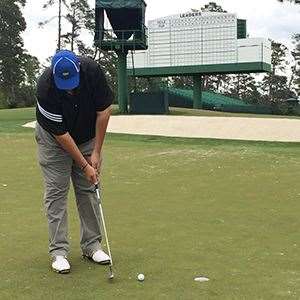

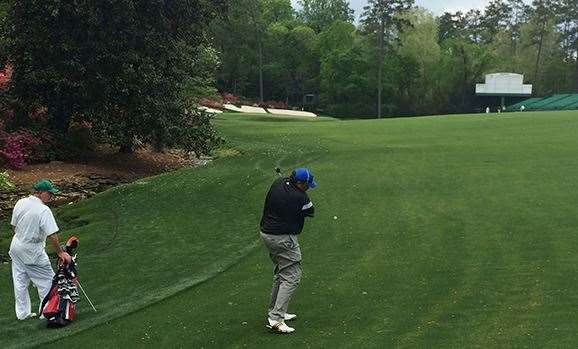






_15th_hole.jpg&h=115&w=225&c=1&s=1)




